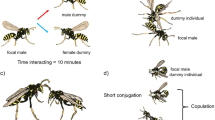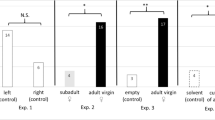Abstract
Several arachnid species use chemicals to detect sexual partners. In harvestmen, there are evidences that chemicals may play a role in intraspecific communication. Using the behavior of Discocyrtus prospicuus (Holmberg 1876), whose males expose the penis to females before they engage in mating posture, we tested if males detect females by contact chemoreception (chemicals left on the substrate) and if males detect females by olfaction. First, we exposed males to three experimental groups, where males had to choose between two substrates: female chemicals/blank control; male chemicals/blank control; female/male chemicals. Then, we gave males access to volatiles of males, females, and control simultaneously. We predicted that males would expose the penis when approaching volatiles and chemicals deposited on the substrate by females. We also tested if males spent more time close to the source of female volatiles and on the substrate with female chemicals and if males tapped the substrate with female chemicals for more time than the others. Finally, we put males and females together to observe if males would expose the penis upon touching the female’s cuticle. Most of our predictions were not supported, though males did tap for more time when exposed to female cues instead of male cues and exposed the penis in 70% of the observations when interacting with the female but only after touching her. Our data does not support olfaction as a way to detect females and corroborate the idea that contact chemicals, either on the substrate or on female’s cuticle, play an important role in the detection and recognition of the opposite sex. This is the first evidence in harvestmen that males may react differently to female/male chemicals.


Similar content being viewed by others
References
Acosta L, Guerrero EL (2011) Geographical distribution of Discocyrtus prospicuus (Arachnida: Opiliones: Gonyleptidae): is there a pattern? Zootaxa 3043:1–24
Aisenberg A, Toscano-Gadea CA, Ghione S (2011) Guía de Arácnidos del Uruguay. De la Fuga, Montevideo
Asai N, Fusetani N, Matsunaga S, Sasaki J (2000) Sex pheromones of the hair crab Erimacrus isenbeckii. Part 1: isolation and structures of novel ceramides. Tetrahedron 56:9895–9899
Barth FG (2002) A spider's world: senses and behavior. Springer, Berlin
Baruffaldi L, Costa FG (2010) Changes in male sexual responses from silk cues of females at different reproductive states in the wolf spider Schizocosa malitiosa. J Ethol 28:75–85
Baruffaldi L, Costa FG (2014) Male reproductive decision is constrained by sex pheromones produced by females. Behaviour 151:465–477
Blomquist GJ, Bagnères AG (2010) Insect hydrocarbons: biology, biochemistry, and chemical ecology. Cambridge University Press, New York
Bruce TJ, Wadhams LJ, Woodcock CM (2005) Insect host location: a volatile situation. Trends Plant Sci 10:269–274
Bruyne M, Baker TC (2008) Odor detection in insects: volatile codes. J Chem Ecol 34:882–897
Buzatto BA, Machado G (2008) Resource defense polygyny shifts to female defense polygyny over the course of the reproductive season of a neotropical harvestman. Behav Ecol Sociobiol 63:85–94
Buzatto BA, Requena GS, Lourenço RS,Munguía-Steyer R, Machado G (2011) Conditional male dimorphism and alternative reproductive tactics in a Neotropical arachnid (Opiliones). Evol Ecol 25:331–349
Byrne PG, Keogh JS (2006) Terrestrial toad lets use chemosignals to recognize conspecifics, locate mates and strategically adjust calling behavior. Anim Behav 74:1155–1162
Cardé RT, Millar JG (2004) Advances in Insect chemical ecology. Cambridge Univ. Press, Cambridge
Cerveira AM, Jackson RR (2013) Love is in the air and on the ground: olfactory and tactile cues elicit visual courtship behavior by Cyrba males (Araneae: Salticidae). J Arachnol 41:374–380
Colazza S, Cusumano A, Giudice LO, Peri E (2014) Chemo-orientation responses in hymenopteran parasitoids induced by substrate-borne semiochemicals. Biol Control 59:1–17
Costa TM, Willemart RH (2013) First experimental evidence that a harvestman (Arachnida: Opiliones) detects odors of non-rotten dead prey by olfaction. Zoologia 30:359–361
Donaldson ZR, Grether GF (2007) Tradition without social learning: scent-mark-based communal roost formation in a Neotropical harvestman (Prionostemma sp.) Behav Ecol Sociobiol 61:801–809
Elias DO, Mason AC, Hoy RR (2004) The effect of substrate on the efficacy of seismic courtship signal transmission in the jumping spider Habronattus dossenus (Araneae: Salticidae). J Exp Biol 207:4105–4110
Elias DO, Sivalinghem S, Mason AC, Andrade MCB, Kasumovic MM (2010) Vibratory communication in the jumping spider Phidippus clarus: substrate-borne courtship signals are important for male mating success. Ethology 116:990–998
Fernandes NDS, Willemart RH (2014) Neotropical harvestmen (Arachnida, Opiliones) use sexually dimorphic glands to spread chemicals in the environment. C R Biol 337:69–75
Font E, Barbosa D, Sampedro C, Carazo P (2012) Social behavior, chemical communication, and adult neurogenesis: studies of scent mark function in Podarcis wall lizards. Gen Comp Endocrinal 117:9–17
Gaffin DD, Brownell PH (2001) Chemosensory behavior and physiology. In: Brownell PH, Polis GA (eds) Scorpion biology and research. Oxford University Press, Oxford, pp 184–203
Gainett G, Michalik P, Muller C, Giribet G, Talarico G, Willemart RH (2017) Ultrastructure of chemoreceptive tarsal sensilla in an armored harvestman and evidence of olfaction across Laniatores (Arachnida, Opiliones). Arthr Struct & Develop. doi:10.1016/j.asd.2016.12.005
Gaskett AC (2007) Spiders sex pheromones: emission, reception, structures, and functions. Biol Rer 82:27–48
Gnaspini P (2007) Development. In: Pinto-da-Rocha R, Machado G, Giribet G (eds) Harvestmen: the biology of Opiliones. Harvard University Press, Cambridge, pp 455–472
Heuschele J, Selande E (2014) The chemical ecology of copepods. J Plankton Res 36:895–913
Machado G, Bonato V, Oliveira P (2002) Alarm communication: a new function for the scent gland secretion in harvestmen (Arachnida: Opiliones). Naturwissenschaften 89:357–360
Macías-Ordóñez R (1997) The mating system of Leiobunum vittatum Say 1821. (Arachnida Opiliones: Palpatores): resource defense polygyny in the striped harvestman. PhD Thesis. Lehigh University, Bethlehem
Macias-Ordóñez R, Machado G, Pèrez-Gozález A, Shultz JW (2010) Genitalic evolution in Opiliones. In: Leonard JL, Córdoba-Aguilar A (eds) The evolution of primary sexual characters in animals. Oxford University Press, Oxford, pp 285–306
Martín J, López P (2015) Condition-dependent chemosignals in reproductive behavior of lizards. Horm Behav 68:14–24
Melville JM, Tallarovic SK, Brownell PH (2003) Evidence of mate trailing in the giant hairy desert scorpion, Hadrurus arizonensis (Scorpionida, Iuridae). J Insect Behav 16:97–115
Munguía-Steyer R, Buzatto BA, Machado G (2012) Male dimorphism of a neotropical arachnid: harem size, sneaker opportunities, and gonadal investment. Behav Ecol 23:827–835
Murayama GP, Willemart RH (2015) Mode of use of sexually dimorphic glands in a Neotropical harvestman (Arachnida: Opiliones) with paternal care. J Nat Hist 49:1937–1947
Owen MA, Swaisgood RR, Slocomb C, Amstrup SC, Durner GM, Simac K, Pessier AP (2015) An experimental investigation of chemical communication in the polar bear. J Zool 295:36–43
Pinto-da-Rocha R, Machado G, Giribet G (2007) Harvestmen: the biology of Opiliones. Harvard University Press, Cambridge
Ruther J, Stahl LA, Steiner S, Garbe LA, Tolasch T (2007) A male sex pheromone in a parasitic wasp and control of the behavioral response by the female’s mating status. J Exp Biol 210:2163–2169
Santer RD, Hebets EA (2009) Tactile learning by a whip spider, Phrynus marginemaculatus C.L. Koch (Arachnida, Amblypygi). J Comp Physiol A 195:393–399
Schulz S (2013) Spider pheromones—a structural perspective. J Chem Ecol 39:1–14
Shorey HH (1976) Animal communication by pheromones. Academic Press, INC, New York
Stafstrom JA, Hebets EA (2013) Female mate choice for multimodal courtship and the importance of the signaling background for selection on male ornamentation. Curr Zool 59:200–209
Stanley E (2011) Egg hiding in four harvestmen species from Uruguay (Opiliones, Gonyleptidae). J Arachnol 39:495–496
Stanley E, Toscano-Gadea CA (2011) Comportamiento sexual en Discocyrtus prospicuus (Opiliones, Gonyleptidae): cuánto más conocemos más nos preguntamos. Memorias y Resúmenes del III Congreso Latinoamericano de Aracnología, Montenegro, p 176
Stoltz JA, McNeil JN, Andrade MCB (2007) Males assess chemical signals to discriminate just-mated females from virgins in redback spiders. Anim Behav 74:1669–1674
Taylor MS, Cosper CR, Gaffin DD (2012) Evidence of mate trailing in the giant hairy desert scorpion, Hadrurus arizonensis (Scorpionida, Iuridae). J Arachnol 40:240–244
Teng B, Dao S, Donaldson ZR, Grether GF (2012) New communal roosting tradition established through experimental translocation in a Neotropical harvestman. Anim Behav 84:1083–1280
Tichy H, Gingl E, Papke M, Schulz S (2001) Female sex pheromone of a wandering spider (Cupiennius salei): identification and sensory reception. J Comp Physiol A 187:75–78
Tietjen WJ (1977) Dragline following by male lycosid spiders. Psyche 84:165–178
Uetz GW, Clark DL, Roberts JA (2016) Multimodal communication in wolf spiders (Lycosidae)—an emerging model for study. Adv Study Behav 48:117–159
Uhrig EJ, LeMaster MP, Mason RT (2014) Species specificity of methyl ketone profiles in the skin lipids of female garter snakes, genus Thamnophis. Biochem Sys Ecol 53:51–58
Vuts J, Powers SJ, Caulfield JC, Pickett JA, Birkett MA (2015) Multiple roles of a male-specific compound in the sexual behavior of the dried bean beetle, Acanthoscelides obtectus. J Chem Ecol 41:287–293
Wicker-Tomas C (2007) Pheromonal communication involved in courtship behavior in Diptera. J Insect Physiol 53:1089–1100
Willemart RH, Gnaspini P (2004) Spatial distribution, mobility, gregariousness, and defensive behavior in the Brazilian cave harvestman, Goniosoma albiscriptum (Arachnida, Opiliones, Laniatores). Anim Biol 54:221–235
Willemart RH, Chelini MC (2007) Experimental demonstration of close-range olfaction and contact chemoreception in the Brazilian harvestman, Iporangaia pustulosa. Entomol Exp Appl 123:73–79
Willemart RH, Hebets EA (2012) Sexual differences in the behavior of the harvestman Leiobunum vittatum (Opiliones, Sclerosomatidae) towards conspecific cues. J Insect Behav 25:12–23
Willemart RH, Chelini MC, de Andrade R, Gnaspini P (2007) An ethological approach to a SEM survey on sensory structures and tegumental gland openings of two neotropical harvestmen (Arachnida, Opiliones, Gonyleptidae). Ital J Zool 74:39–54
Willemart RH, Farine J-P, Gnaspini P (2009) Sensory biology of Phalangida harvestmen (Arachnida, Opiliones): a review, with new morphological data on 18 species. Acta Zool 90:209–227
Willis MA, Avondet JL (2005) Odor-modulated orientation in walking male cockroaches Periplaneta americana, and the effects of odor plumes of different structure. J Exp Biol 208:721–735
Wyatt TD (2014) Pheromones and animal behavior, communication by smell and taste. Cambridge University Press, Cambridge
Acknowledgements
We thank the members of the LESCA lab (Laboratory of Sensory Ecology and Behavior of Arthropods) for reviewing an early draft of the manuscript: Gabriel Murayama, Guilherme Gainett, Guilherme Pagoti, Jessica Dias, Julio Segovia, Norton Silva and Thaiany Costa. Maurício Bento Simões, Pedro Leite Ribeiro, and José Eduardo Carvalho also read and provided nice comments. We thank the two anonymous reviewers for the careful revision. This study was funded by FAPÈSP 2010/00915-0 and 2015/01815-9.
Author information
Authors and Affiliations
Corresponding author
Rights and permissions
About this article
Cite this article
Fernandes, N.S., Stanley, E., Costa, F.G. et al. Chemical sex recognition in the harvestman Discocyrtus prospicuus (Arachnida: Opiliones). acta ethol 20, 215–221 (2017). https://doi.org/10.1007/s10211-017-0264-5
Received:
Revised:
Accepted:
Published:
Issue Date:
DOI: https://doi.org/10.1007/s10211-017-0264-5




